As promised: your mega-raptor (and Canada Goose!) Nestflix Wednesday Matinee! DN15 and DN16 turn 39 and 38 days old today and are up to tweagle shenanigans: E-gulping fish, Eagle Kneiveling around the nest, practicing their Eagleibrium, and holding Flappathons as they explore their rapidly growing wings! It won’t be long before our two teen pterodactyls turn into sleek young fledglings, but there are plenty of Eagleicious Delicious moments to enjoy before that happens. Look for walking skills and balance to improve in the next week as the eaglets gain experience and coordination, and slowly grow out their plushy tushy tails!
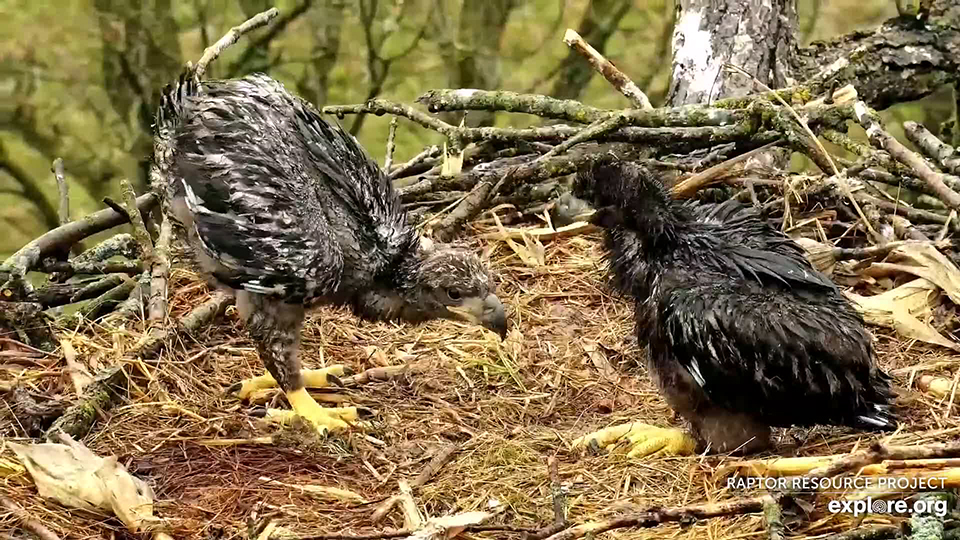
May 3, 2022: DN16 and DN15 are big eagles now!
Do Canada geese commonly nest in trees and/or bald eagle nests?
A lot of you have been asking how common it is for Canada geese to nest in bald eagle nests. While I haven’t been able to find a definitive answer, geese have been documented nesting in bald eagles nests, osprey nests, great blue heron nests, and red-tailed hawk nests since at least 1928. Here’s a link to one example: https://sora.unm.edu/sites/default/files/journals/wilson/v040n03/p0139-p0149.pdf. It’s worth checking out for the information, the writing style, and the observation that Canada Geese were relatively new to Yellowstone at the time. The author thought they were fleeing unrestricted shooting and noted that they seemed more approachable than their counterparts in unprotected places.
By the mid-1960s, Canada Geese had become somewhat rare and Bald eagles were almost completely extirpated from most of the lower 48 United States, so there weren’t many abandoned bald eagle nests for geese to choose. Bald eagle nests came back with the Bald Eagle and some geese returned to selecting them for nesting. I would love to know if this behavior persisted in northern Wisconsin and Maine: the last great strongholds for bald eagles and Canada Geese through the 1950s and 60s. Simply put: this behavior is new to us, but it is not new to Bald Eagles or Canada Geese. I have downloaded datasets for BBL’s Breeding Bird Surveys and hope to write more about this fascinating story!
Decorah North Nest
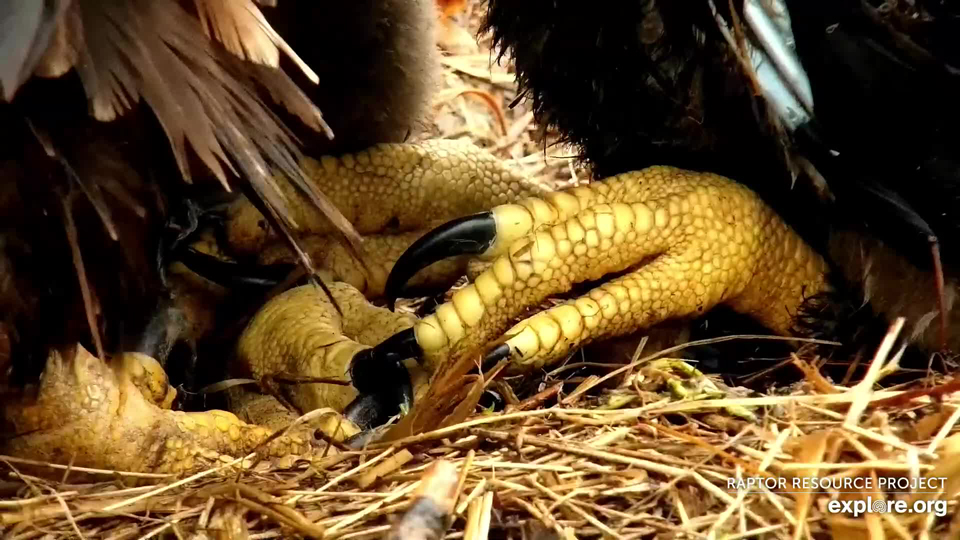
May 3, 2022: DNF and DN15. DNF’s toes are more robust, but DN15’s 38 day-old feet aren’t far behind!
May 3, 2022: Wow! The feet! At just over 5 weeks and as big as Mom’s! https://youtu.be/OxE5wRsMtm0. Mom’s toes are more robust, but DN15’s 38 day-old feet aren’t far behind! Admire talons and wet feathers, and watch at 1:16 to see DN15 nibble Mom’s talon and take shelter under her Mombrella.
May 3, 2022: Mr. brings a fish, DNF feeds, 16 is a peaglet – https://youtu.be/HiIAuCovoGU. Eagle college is in session! DN15 and DN16 are about halfway to fledge, which means they need to work on coordination, muscle, and self-feeding skills. The two walk unsteadily towards DNF (look for DN16’s wing-assisted step at 49 seconds). DN16 gets tired of waiting for breakfish and reaches in to take several large bites before gulping the whole fish down at 3:45! Fortunately, there are still a few nestovers left for DN15. Once breakfish is done, the two moist fowlettes do their best to escape the rain by burrowing beneath DNF’s protective feathers.
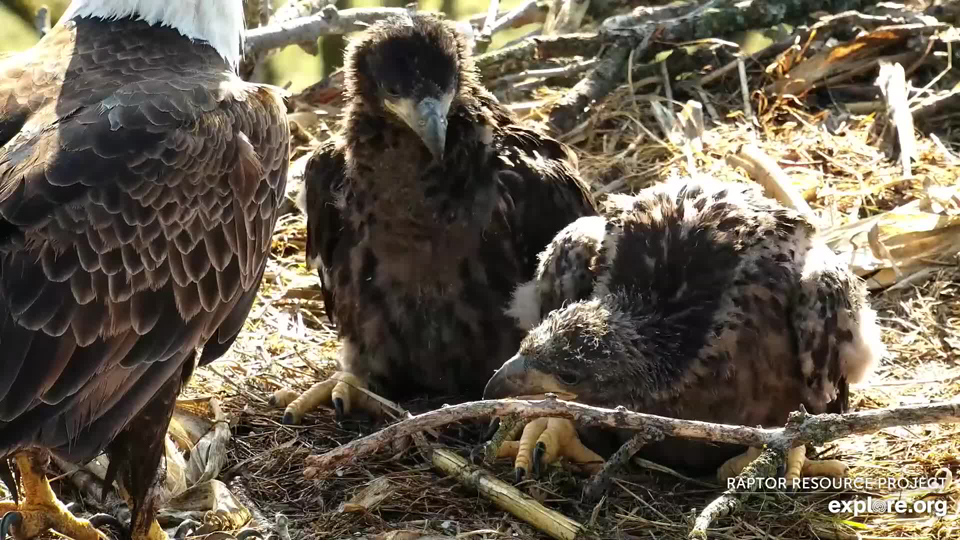
May 4, 2022: Feeding time will get a little riskier for adult toes and talons as DN15 and DN16 get stronger, more coordinated, and even hungrier!
May 1, 2022: DN15 & 16 fun with husk, closeups, Mr. delivers another toy – https://youtu.be/2sGqLKeI28g. The video opens with excellent close-ups of DN15, who has – I counted! – about 16 natal down dandelion puffs left on top of its head! What are the eaglets doing? At 1:42, DN15 lifts a corn stalk up. The two nibble, explore, and play tug-o-war with their new toy. Look for a wide-angle view at three minutes (DN15 left, DN16 right) and another toy delivery by Mr. North at 4:03!
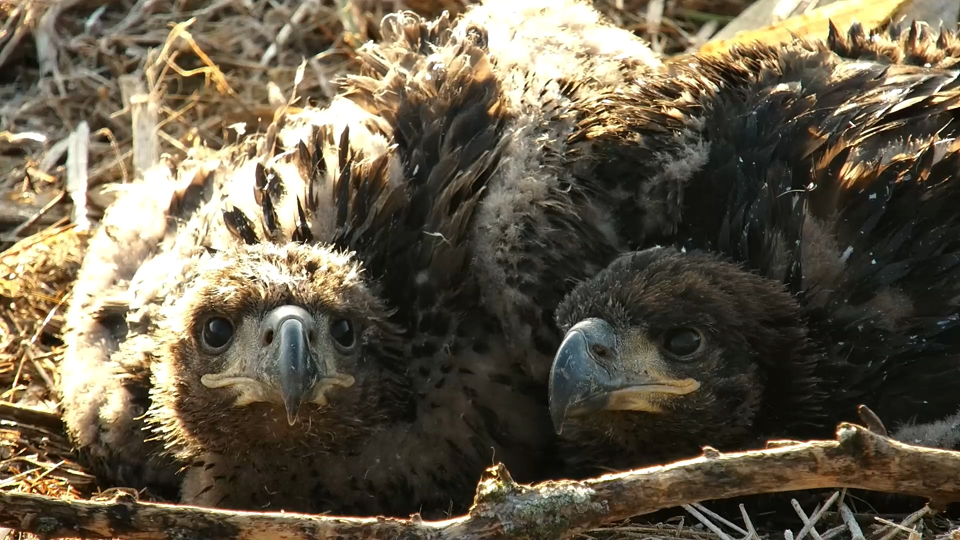
May 4, 2022: We love cuddle puddles! DN16 left and DN15, right.
May 1, 2022: Morning Calisthenics, eaglet style – https://youtu.be/WkSSw_BLMRM. It’s not very easy to stand, especially when your tail hasn’t grown in to balance you yet! DN16 (left) and DN15 (right) stand, clumsily walk (get back from the edge, DN16!), and hold a mini-flapathon on an early May morning.
Decorah Eagles and Canada Geese
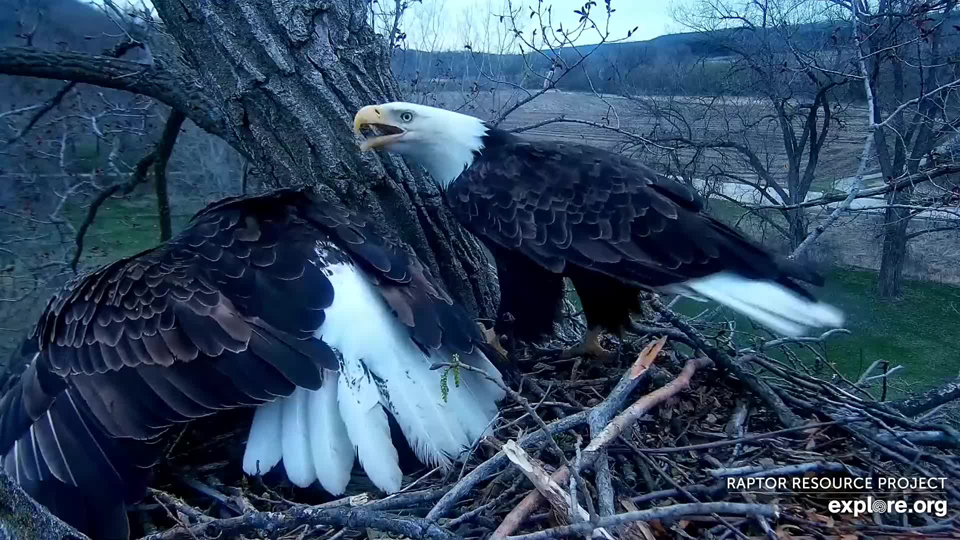
May 2, 2022: Someone doesn’t feel like sharing dinner! He’s mantling and she’s moving in.
May 3, 2022: Geese on the skywalk – https://youtu.be/i_x5jjQonnQ. Two geese explore N2B, with some cool closeups starting at 1:28. Could they be looking to lay eggs? Geese are egg dumpers, aka conspecific brood parasites, which means that they sometimes lay their eggs in the nests of other geese. They also like to lay in and around areas where other geese are nesting. N2B comes pre-loaded with an unhatched egg and one brood has already been produced here. We’ll see what happens!
Geese normally only lay one clutch a year, but arrival and nesting times vary considerably. Since Canada geese breed from March through the end of June and each clutch takes about 35 days to produce, we could in theory see as many as three clutches fledge from N2B.
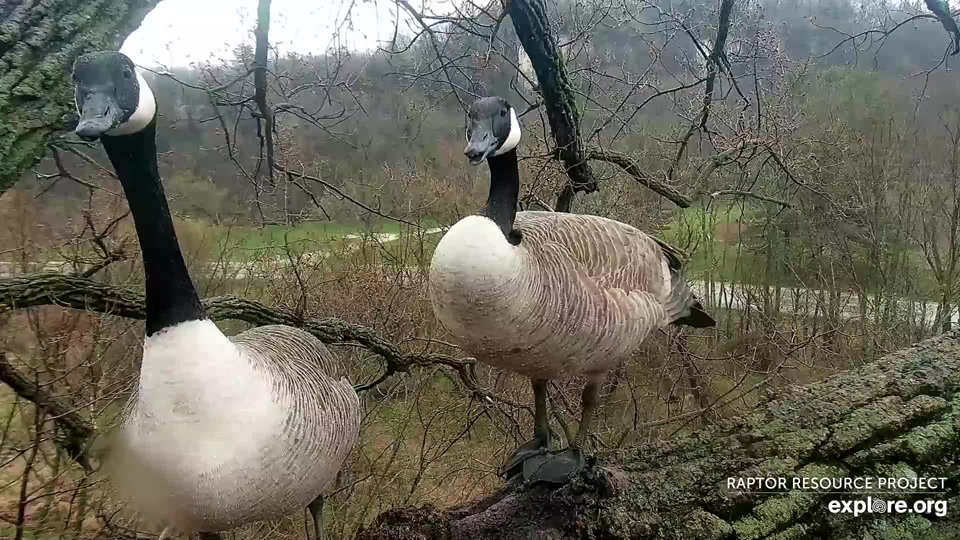
May 4, 2022: A new goose pair explores N2B.
May 2, 2022: Defending a late night snack – https://youtu.be/iQQSlZWNB3M. The video opens with the N1 eagles warning an osprey away from their tree (slow the video down at 5 seconds to see it swoop by). At 1:42, we see that the male, who is perched on the lower branch, has a fish in his talons. His mate begins pleading and, when he doesn’t respond, flies down at 2:11 to take the fish. He doesn’t feel like sharing and the fish chase is on! We have a fish fight at 3:15, another altercation at 6:09, and more pleading after the male flies behind the N1 trunk. She tries to once more to get the fish at 10:09, but he flies out with his prize and does not return.
April 30, 2022: Turkey vulture eats fish by the pond – https://youtu.be/NbyG7hSxNY4. Watch how the vulture eats and you might notice that it stands on the fish, but doesn’t tear with its feet. Turkey vultures have relatively weak feet and talons, which means that they have a hard time tearing into fresh carcasses. They rely on vehicles, other animals, or decay to weaken the flesh and open the carcasses for them.
Are turkey vultures really raptors? It depends on who you ask. Unlike most raptors, vultures have weak, non-grasping feet tipped with dull talons. Female and male vultures are roughly the same size and they feed on carrion instead of hunting live prey. However, they share a common ancestor with accipitriformes (hawks and eagles) and live a generally ‘raptorial’ lifestyle, with longer life spans and larger bodies and home ranges than other terrestrial birds. Are turkey vultures really raptors? This argument is far from settled, but I’m all for placing them in the order Cathartiformes: https://birdsoftheworld.org/bow/species/cathar2/cur/introduction.
April 30, 2022: Eagle chased a goose, both eagles worked on the nest – https://youtu.be/gvQS_ROvcbU. Look for the eagle/goose chase at 2:22 – geese are fine neighbors, but not welcome in the nest! – some wonderful spring footage on the Y, and nestorations at 8:10.
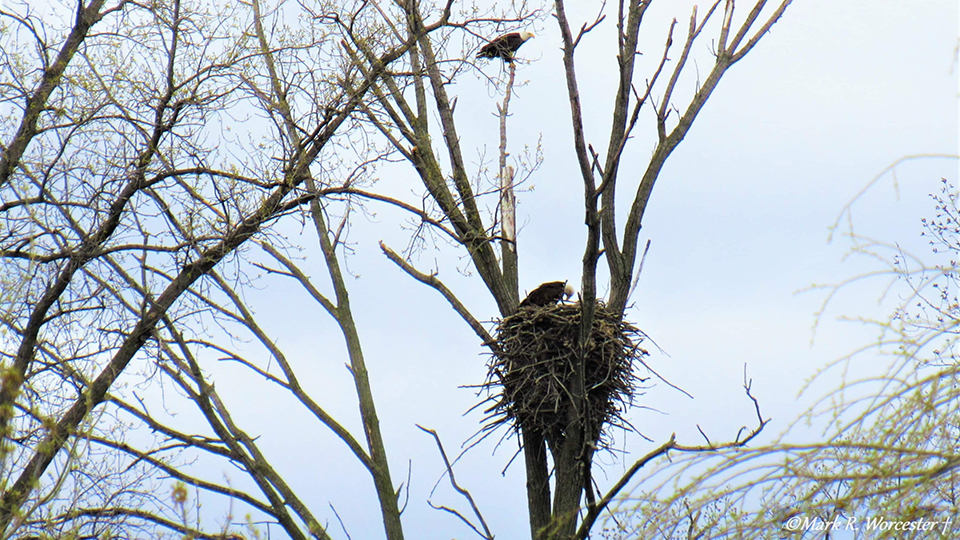
May 3, 2022: Two eagles at N3. Photo by Mark Worcester.
How long have these eagles been hanging around? It’s a little hard to tell, since we were seeing Mom and DM2 on and around N1 back in February, or so we think. We know that Mom appeared to lay an egg in N3 in late February, didn’t begin full incubation until March 21, and quit incubation on or around April 17. She and DM2 appeared to be drifting away from N3, although photographer Mark Worcester spotted two eagles there on May 3.
Given the timeline, we shouldn’t have seen Mom and DM2 together at the hatchery between March 21 and April 15. But we have several videos showing two eagles – the new eagles – in and around N1 in late March. We started to see a lot more of them after N1 nestwork began on April 3rd, possibly interspersed with visits from Mom or DM2. We think we saw different eagles on April 15 and April 16 and we know we saw eagle altercations on the night of April 24, but the eagles aren’t cooperating with our attempts to log features like iris flecks or distinctive feathers. We’re pouring over our footage and will keep everybody posted. If Mom or DM2 want to check in, we’re all ears – but in the meantime, join the RRP crew and enjoy the ride!
Odds and Ends
Take a look at the Recovering America’s Wildlife Act
Click the tabs on each congressional page to learn more about progress and sponsors. This bill enjoys a lot of bi-partisan support. Let’s ask our representatives to put their money where their mouths are and pass it!
What language do we speak? We call it Eagle-ish! Learn how to interpret it with our Diction-Aerie: https://www.raptorresource.org/2021/10/06/presenting-the-diction-aerie/.
 The Raptor Resource Project
The Raptor Resource Project The Raptor Resource Project
The Raptor Resource Project